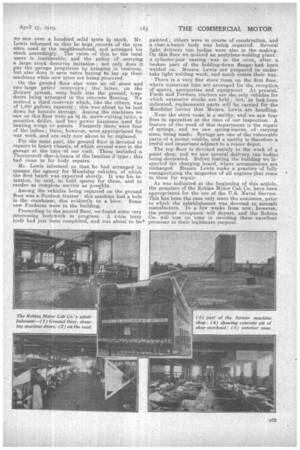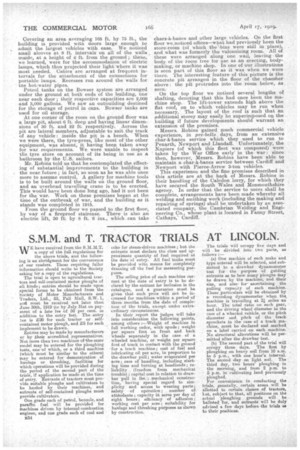SERVICE FOR SOUTH WALES USERS.
Page 10

Page 11

Page 12

If you've noticed an error in this article please click here to report it so we can fix it.
Islandslays and Caledons Handled by Cardiff Approved Depots.
WHOSO SETS FOOT for the first time in South Wales, does not take long to realize, not only the great extent to which motor traction has been utilized in this wealthy and densely-populated locality, but also the vast possibilities that yet remain for such development. From the excellent handbook of approved depots, issued .by the C.M.U.A., we learned that there were in the Welsh metropolis two establishments officially recognized by that association, and on a recent visit to Cardiff we took the opportunity to inspect both of these, in order to see for ourselves how far facilities had been provided for affording the necessary ser-. yice to the users of that district.
As is only to be expected, the smooth working of both depots has been impaired during the war, by reason of the Government having claimed both machinery and men. One establishment, that of the Robins Motor Cab Co. in Park Place, has been commandeered in toto for the use of the United States Naval authorities, in whose occupation it still is. Happily, there is now every evidence that affairs will soon revert to the normal, and already a serious start has been made to hasten this return.
Our first visit was to the premises of Messrs. W. Lewis and Sons, Clare Street., Cardiff. Situate in a side street off Tudor Road, this building is a fine concrete structure, to which admission is gained through sliding doors; the latter are arranged so that access to the whole of the ground floor of the Main building may be had direct from the road. Thus there is no difficulty in running the largest vehicles into the building. On the occasion of our visit the weather was bitterly cold ; once inside however, we experienced the comforting sensation of warmth, due to the hot-water pipes with which the entire building is provided. This feature makes a favourable, impression on the visitor : a properlywarmed garage dispenses with the necessity for running off the jacket water from engines in frosty weather, and, besides, renders the place far more comfortable for the men working there. The effect of the latter item on men's output is bound to be favourable.
The first thing to command our attention was the lift, placed centrally on the ground floor, opposite the middle of the sliding doors. This lift (by Messrs. H. 0. Strong, of Bristol) was actuated by a singlephase, alternating-current electric motor, and had a nominal capacity of two tons. It is used for conveying the bodies of chars--banes or of heavy vehicles to the first and• top floors of the building ; it also takes light delivery yams with ease. The motor derives its current from the Cardiff mains, which also supply the necessary power for the machines, blacksmith-6' fires, etc., there being a separate motor in each department.
Adjacent to the lift are two pits, alongside of which is a fitter's bench ; between the pits is the tyrepress. Overhead blocks and tackle are arranged in this part of the shop, a featnre that will be appreciated by anyone who has ever handled twin-tyred rear wheels.
Close to the tyre-press is a solid-tyre store, where we saw oVera hundred solid tyres in stock. Mr. Lewis informed us that he kept records of the tyre sizes used in the neighbourhood, and arranged his stock accordingly. The value of this to the local users is inestimable, and the policy of carrying a large stock deserves imitation ; not only does it pay the garage proprietor by bringing in business, but also does it save users having to lay up their machines while new tyres are being procured.
On the ground floor also were an oil store and two large petrol reservoirs ; the latter, on the Bowser system, were built into the ground, trapdoors being arranged in the concrete flooring. We noticed a third reservoir which, like the others, was of 1,000 gallons capacity; this was about to be laid down for benzoic storage. Among the machines we saw on this floor were an si in. screw-cutting lathe, a sensitive driller, and two power hammers used for beating wings or panels. Formerly there were four of the lathes ; three, however, were appropriated for war work, and are only now about to be replaced.
For the most part, the ground floor is devoted to repairs to heavy chassis, of which several were in the garage at the time of our visit. These included a Thornycroft char-h-bancs of the familiar J type ; this had come in for body repairs.
Mr. Lewis informed us that he had arranged to assume the agency for Maudslay vehicles, of which the first batch was expected shortly. It was his intention, he said, to hold spares for these, and to render as complete service as possible., Among the vehicles being repaired on the ground floor was a Fordson tractor : this machine had a hole in the crankcase, due evidently to a blow. Some new Fordsons were in the building.
Proceeding to the second floor, we found some very interesting bodywork in progress. A 4-ton lorry body had just been completed, and was about to be painted; • others were in course of construction, and char-a'-banes body was being repaired. Several light delivery van bodies were also in the making. On this floor we noticed an acetylene-welding plant :
a cylinder-pair casting was in the oven, after a broken part of the holding-down flange, had been
welded on. Messrs. Lewis are prepared to undertake light welding work, and much comes their way.
There is a very fine store room on the first floor, where numerous bins are arranged for the reception of spares, Acce ssor les and equipment. At present, Fords and .Fordson tractors are the only vehicles for which extensive stocks are held ; but, as has been
indicated, replacement parts will be carried for the M.audalay lorries that Messrs. Lewis are handling. Near the store room is a smithy, and we saw four fires in operation at. the time of our inspection. A feature of the work of this department is the repair of springs, and we saw sprmg-leaves, of varying sizes, being made. Springs are one of the vulnerable parts of a Motor vehicle, and a smithy is therefore a useful and important adjunct to a repair depot.
The top floor is devoted mainly to the work of 4, paint shop, and we saw several delivery van bodies being decorated. Before leaving the building we inspected the charging board, where accumulators are recharged. Messrs. Lewis make a practice of fully remagnetizirig the magnetos of all engines that come to them for repair.
As was indicated at the beginning of this article, the premises of the Robins Motor Cab Co. have been appropriated for the 'use of the U.S. Naval Service.
This has been the case only since the armistice, prior to which the establishment was devoted to aircraft manufacture. In a few weeks from now, however, the present occupant ii will depart, and the Robins Co. will lose no time in devoting these excellent premises to their legitimate purpose.
Covering an area averaging 165 ft. by 75 ft., the building is provided with aoors large enough to admit the largest vehicles with ease. We noticed small alcoves at 8 ft. intervalson all of the walls inside, at a height of 4 ft. from the ground; these, we learned, were for the accommodation of electric lamps, which thus projected their light where it was most needed. Cables are arranged at frequent intervals for the attachment of the connections for portable lamps. Recesses run around the walls for the hot-water pipes. Petrol tanks on the Bowser system are arranged under the ground at both ends of the building, one near each door ; their respective capacities are 2,000 and :3,000 gallons. We saw an outbuilding destined for the storage of petrol in cans. Bowser tanks are used for oil storage.
At one corner of the room on the ground floor was a large pit, about 6 ft. deep and having linear dimensions of 30 ft. and 22 ft: respectively. Across the pit are lateral members, adjustable to suit the track of any vehicle : inside the .pit is a bench. When we were there, the tyre-press, like most of the other equipment, was absent, it having been taken away for war requirements. We were unable to inspect tile, tyre store on account of its being in use as a bathroom by the U.S. sailors.
Mr. Robins told us that he contemplated the effecting of substantial improvements to the building in the near future; in fact, so soon as he was able once more to assume control. A gallery for machine tools is to be built around the walls on the ground floor, and an overhead travelling crane is to be erected. This would have been done long ago, had it not been for the war. Work on these premises began at the time of the outbreak of war, and the building as it stands was completed in 1915.
From the ground floor we passed to the first floor, by way of a fireproof staircase. There is also an electric lift, 30 ft. by 8 ft. 6 ins., which can take chars-a-banes and other large vehicles. On the first floor we,noticed offices—what had previously been the store-room (of which theNbins were still in place), and what was formerly the vulcanizing room. All of these were arranged along one wall, leaving the body of the room tree for use as an erecting, bodymaking, or machine shop. In one of our illustrations is seen part of this floor as it was when we were there. The interesting feature of this picture is the concrete pit arranged in the floor of the chamber above : the pit protrudes into the room below, as seen.
On the top floor we noticed several lengths of shafting, denoting that this had once been the machine shop. The lift-tower extends high above the flat rOof, on to which vehicles may be run when necessary. The layout of the roof is such that an additional storey may easily be superimposed on the building if future developments should warrant an extension of the premises.
Messrs. Robins gained much commercial vehicle experience, in pre-bellodays, from an extensive char-a-iloancs service which they used to run to Penarth, Newport and Llandaff. Unfortunately; the Napiers (of which this fleet was composed) were taken by the War Office early' in the war : since then, however, Messrs. Robins have been able to maintain a char-h-bancs service between Cardiff and Newport with Pierce-Arrow 3-ton vehicles. This experience and the fine premises described in this Article are at the back of Messrs. Robins in their handling of the Caledon lorry, for which they have secured the South Wales and Monmouthshire agency. In order that the service to users shall lie complete, arrangements have been made whereby all swelding and smithing work (including the making and repairing of springs) shall be undertaken by an associated company, the Cambrian Welding and Engineering Co., whose plant is located in Fanny Street, Cathays,‘ Cardiff.






















